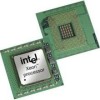Intel BX80605X3430 Data Sheet - Page 15
Thermal Management Support, Package, Terminology - fan
 |
UPC - 735858210331
View all Intel BX80605X3430 manuals
Add to My Manuals
Save this manual to your list of manuals |
Page 15 highlights
Introduction 1.4 1.5 1.6 Thermal Management Support • Digital Thermal Sensor • Intel® Adaptive Thermal Monitor • THERMTRIP# and PROCHOT# support • On-Demand Mode • Memory Thermal Throttling • External Thermal Sensor • Fan Speed Control with DTS Package • The processor socket type is noted as LGA 1156. The package is a 37.5 x 37.5 mm Flip Chip Land Grid Array (FCLGA 1156). Terminology Term Description DDR3 DP DMA DMI DTS ECC Enhanced Intel SpeedStep® Technology Execute Disable Bit FCLGA (G)MCH ICH IMC Intel® 64 Technology Intel® Hyper-Threading Technology Intel® Turbo Boost Technology Intel® TXT Third generation Double Data Rate SDRAM memory technology Display Port* Direct Memory Access Direct Media Interface Digital Thermal Sensor Error Correction Code Technology that provides power management capabilities. The Execute Disable bit allows memory to be marked as executable or nonexecutable, when combined with a supporting operating system. If code attempts to run in non-executable memory, the processor raises an error to the operating system. This feature can prevent some classes of viruses or worms that exploit buffer overrun vulnerabilities and can, thus, help improve the overall security of the system. See the Intel® 64 and IA-32 Architectures Software Developer's Manuals for more detailed information. Flip Chip Land Grid Array Legacy component - Graphics Memory Controller Hub. Platforms using LGA 1156 processors do not use a (G)MCH component. The legacy I/O Controller Hub component that contains the main PCI interface, LPC interface, USB2, Serial ATA, and other I/O functions. It communicates with the legacy (G)MCH over a proprietary interconnect called DMI. Platforms using LGA 1156 processors do not use an ICH component. Integrated Memory Controller 64-bit memory extensions to the IA-32 architecture. The processor supports Intel® Hyper-Threading Technology (Intel® HT Technology) that allows an execution core to function as two logical processors. Intel® Turbo Boost Technology is a feature that allows the processor core to opportunistically and automatically run faster than its rated operating frequency if it is operating below power, temperature, and current limits. Intel® Trusted Execution Technology Datasheet, Volume 1 15















